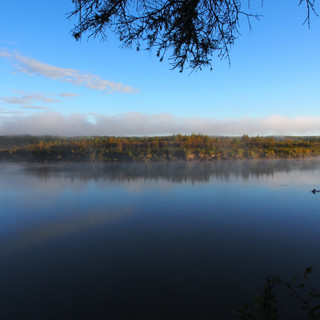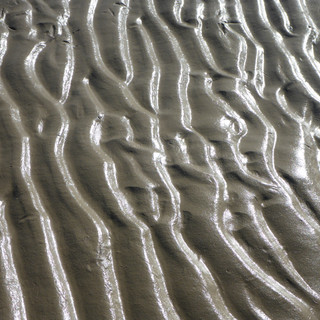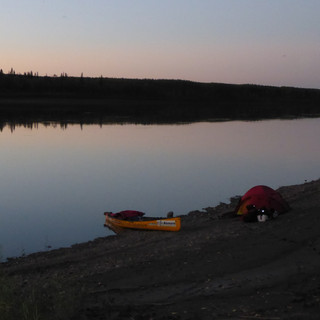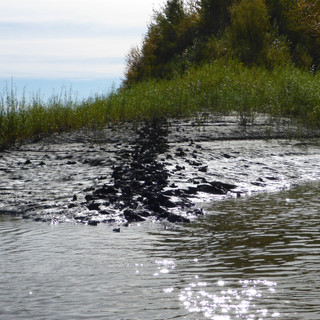Fort Chipewyan (AB) to Peace River (AB) / August 18 - October 1, 2016
Thursday, August 18 to Saturday, October 1, 2016
After a very long wait, we finally received our first package on August 18, at the post office in Fort Chipewyan. The next day, a second package arrived (not without spending long hours on the phone with Canada Post). The third package was unfortunately returned to Quebec. While waiting for our packages to arrive, we spent time with Derek. We shared meals together and helped him with his project of building a shed. We also spent the evening with Daniel (from New Brunswick) and his wife Clara (who also invited us to have lunch with them the next day). So, it is on Monday, August 22 that we left this small and charming community of less than 1,000 inhabitants. Fort Chipewyan was once a very important trading post. Before we left, a last goodbye to our friend Derek on the beach of the park.
We followed the Quatre Fourches river at the outlet of Lake Athabasca. We saw several bald eagles along the way. As we were getting closer to the Peace River, we felt butterflies in our stomach. We had many apprehensions about this river. So many people have told us that we would not be able to paddle against the current; that the current was too strong.
Our first impressions of the Peace River were strong. The river was wide, the current was actually strong and the water was very silty. We did not see any of our paddles in the water. Our first stop for the night was on a little piece of sand on an island. The shoreline was mud. This reminded us of the North Saskatchewan River.
The second day, we took a passage behind the islands. According to maps and GPS, there was no problem to paddle there. It would return to the main channel. But, there was not enough water and we had to turn back. Two hours lost ... lost yes and no, because this trip allowed us to have a close encounter with a wolf. He seemed not to be afraid and approached quietly. I think I was more nervous than he was. We could hear his pack further. The pack had to be close in the trees located about 200 meters behind him. For his part, the lone wolf was no more than 400 meters away from us. Pierre was excited. He filmed the scene. I did not want to stay too long. The wolf kept on approaching. We were in shallow water and it was narrow. Jasmine barked lustily, but the wolf had no fear of her. Maybe he was sick.
Around 6:00 p.m., it’s another kind of surprise we had. We had a visit! Derek came to see us. It took him two hours by boat from Fort Chipewyan to join us. We had dinner with him before he left. He probably arrived in the dark at home. What a nice surprise it was!! In addition, Derek brought us water.
The next day, it is a black bear we saw crossing the river. Jasmine got too excited by his presence and she felt into the water. She came back by herself to the canoe. Once back on the canoe and after getting us all wet after shaking herself, she looked at us and wiggled her tail. She knew she had pushed her luck. Silly dog!
Landscapes changed as we progressed. We saw cliffs of limestone and sand. We saw layers
of different colors in the walls overlooking the river (clay, mud, alternating sand and even rust color). Mosquitoes and blackflies were in abundance at the beginning, despite the growing cold. There was a lot of erosion at some places and trees in the water forcing us to leave the shoreline and paddle into the strongest part of the current. Geese were numerous and chattered all night. We also noticed that the leaves began to change color. It was a sign that the fall was just around the corner. Every morning, the tent was covered with a thick carpet of dew. The tent was heavy with the weight of those millions of droplets. However, when we were blessed with sunlight, water particles shone bright before dissipating.
Then, the Boyer Rapids. Nothing monstrous except that the river is 2 km wide at this point. We had to rope the canoe because of the strength of the current and the lack of water. Several rock barriers cross the river on at least one third of its width. In addition, due to lack of visibility in the water and the lack of visible signs on the surface of the water, we often touched the rocky bottom with our paddles. We were glad when we finally completed the rapids section and that the riverbed had returned into sand. That day, we saw hundreds of swallow nests anchored to the walls of the cliffs in addition to seeing a hawk. After the rapids, we found also an island where there was plenty of sand and lots of wood. We set up camp in anticipation of the rain. With all the resources available on the island, we created a very comfortable camp.
The next day on August 27, we stayed put because of heavy rain. We were not into miserable conditions and honestly, were very comfortable. We were able to collect also 40 liters of fresh water (which we needed). That day, we also had strong wind. In the afternoon, the sand dried up and it's a sand storm we had for the rest of the day. The sand seeped everywhere and stuck on all pieces of equipment despite our best precautions. It was only once the zips closed on the tent that we could finally dust off ourselves. It is also on that day that we put our hats on for the first time. We were treated to 25C during the last days.
August 28 was freezing. The wind was strong and the river was raging. We also saw pelicans (this was a long time since we had seen them).
The following day, we had to think about the water level. In 12 hours on August 29, we noticed that the water level had risen by 12 inches. What was happening?! Our friends Jim and Lisa searched to understand. The increase was caused by the heavy rains received in the west and water released from the Bennett Dam (located upstream, over 1,000 km away from us). Certainly, the water level rose quickly and permanently as did the strength of the current.
One night we stopped on the tip of a muddy and sandy bar. We were treated to the best concert of nature (near Big Slough). It was 9:50 p.m. when it all began. It was already dark. Everything echoed. Two wolf packs sang on each side of the river. Coyotes joined the group not long after; then a bear. And a beaver family that seemed to wonder what that big red thing and this long yellow thing were (our tent). We believe we heard also buffalo moans. All this went on for hours. It was great and to rethink of it, I still have chills.
Continuing on our way west, we also began to witness waste along the shoreline (WD-40, gas barrels). Too bad, because we were still in the Wood Buffalo National Park. Approaching Garden Creek (a native village), we saw four young people from the other side of the shore. They shouted to attract our attention and we responded. Then we decided to cross the river to go talk with them. It was not the right place to cross. Normally, we would have waited further down the curve. Worse, the people fled before we arrived. We found it very strange. It was the first time it happened to us. Several kilometers further, we arrived at the village. We saw two other young people on the edge of the ramp. We stopped to seek information about where we might find the store to buy food. The teenagers had difficulty answering in English. They spoke Cree. They also seemed to be afraid of us. Nevertheless, one of them told us that the store was located near "the point that go cling-cling". He spoke about the church tower. We therefore left and stopped again in front of the church. The slope was steep and I could not see the top. Pierre left alone to go to the store. He returned confused. People in the store spoke virtually no English. They had difficulty answering. They seemed to be afraid of Pierre. On the walls were displayed Alberta welfare programs and a salt reduction program. He said it was the most miserable reserve he had seen. Everything was falling apart. There was no maintenance of the buildings. Each house has between 2-4 dogs in the yard along with snowmobiles, quads and trucks. On his way back to the canoe, he met two drunken women driving their trucks and trying to sell him a Bible.
It was raining that day. It was cold and we still had not seen a place to stop to camp. Normally, we would have asked permission to sleep on the reservation. But this time, we decided to move on. It was only later that we learned that in the mythology of the people living there, that there are little people, little mischievous men who live on an island not faraway. We might have been identified as these little characters.
With our tarp, we kept the camp dry overnight. Amazing to think that it has been more than 500 days that we have been using this tarp (from Hilleberg the Tentmaker). Unfortunately, what was already wet did not have time to dry. There was fog and then light rain in a.m. Nevertheless, we kept on paddling and saw the decrease in the distance separating us from the first large village of the river, Fort Vermilion. Along the way, we saw 4 swans flying and lots of fresh animal tracks. We were also officially out of Wood Buffalo National Park. By late afternoon on September 1, we stopped on a sand strip surrounded by very slippery, sticky and viscous mud. We had to be careful not to lose our footing. Then, just after finishing putting up the tent, the rain started. It blew too hard to put on the tarp this time (gusts exceeding 50 km/h). So we had dinner in the tent. We also had breakfast in the tent the next morning. We stayed there until there was a lull during the day. We prepared bannock (we were out of bread) and found refuge in the tent again for another episode of wind and rain. In the afternoon, while Pierre went out of the tent he surprised a black bear that was crossing to reach our island. Jasmine saw it and started to bark. The bear swam away in the opposite direction. An hour later, the same scenario happened again. Jasmine was really mad. No intruder allowed on her island. She was hopping with anger and yelping enough to hurt our eardrums. Then we saw a moose on the other side of the river. Life is very abundant on the Peace River. Since we left Fort Chipewyan, we were greatly impressed by the diversity and
abundance of animals. We had the impression of being in an open-air zoo.
It is only on Sunday, September 4 we could leave the island. Winds of more than 50km/h and rain restrained us from continuing our journey. September 4 was a cold day. Our hands were freezing and our dried skin hurt. I must say that on that morning we felt that we could not wait to arrive in Fort Vermilion (to retrieve the box of warm clothes and winter boots our friends Mireille and Dave sent us). At lunch, we were frozen. Our wet neoprene boots did not warm our feet. We kept on gigglilng throughout the meal to keep us warm. Our progression was difficult with an average of just 3 km/h. The current was still very strong and the water level continued rising. It was also getting more difficult to find a place to stop too.
Near the Fox Lake reserve, we saw two boat platforms used as ferries to reach the other bank and connect with John D'Or reserve. We saw several fishing lines hung on sticks ... and waste such as blue latex gloves. On all rivers we travelled so far, it is always similar. It is easy to know when approaching a village because of the waste. However, there are better places with less waste and some other worse places. All this makes us sad. But despite this, we met very friendly people. We stopped at Little Red River. We met Chester & Trenton, two natives of Fox Lake reserve. Both were fishing. Chester gave us a wealth of information. He is a Cree teacher. His views on youth education are really interesting. Trenton is a firefighter. And he took a great catch during our discussion - a walleye over 7 pounds! We chatted with them until 10:30 p.m. It was only 2C when we went to bed. The dew had already fallen heavy.
The day of September 5 was a big one. We arrived at the Vermilion Falls. But before leaving Little Red River, we met David and John, two young Ontario teachers. They love living here. They are well suited to the lifestyle of this remote region. They are enthusiastic and passionate. They also see the efforts on education. They are confident that the future of young native people will change with good education. Thirty million dollars has been invested into Fox Lake School and according to them, they already see positive effects. John also gave us a pike he caught during our discussions.
The approach to find the portaging trail next to the falls was not easy, even hard. The falls are impressive and are 2 km wide. The place where we were supposed to land was flooded. The water level was still rising, as was the flow. Jim and Lisa informed us that on that day, the water flow was 3300 m3/s. The normal is 1700 m3/s. Therefore, we had to find another place to land and clear our own path. With the machete, Pierre climbed like a mountain goat on the steep cliff. He cut trees, shrubs and roses bushes to clear a path about 250 meters long to the top of the cliff. Then, he tied ropes to help us to climb with our equipment on our backs. It took us three hours to portage from the river (below the falls) to the top. We had to pull ourselves with the rope and trees. The hardest part was getting the canoe up. In turn, we took a load on our back and moved a little higher every time. It was only at the top that we could relax a little. But the effort was great. It's one of those moments when you feel like giving up to lie down on the ground like in small ball. Then, we walked a little further until we found a suitable place to set up camp. We had a fantastic view of the falls. With the sun setting over the falls, it was beautiful. With that simple view, all the pain was gone. We knew that the effort was totally worth it. To see that, it was our reward. One must remember that after every difficult moment, there is always a more beautiful and grand moment that will justify our efforts and elevate ourselves. We were very well rewarded that day. After removing the roses thorns from our hands, we ate John’s fish and spent time around a warming fire.
The next day, four partridges came to visit us. We made an easy portage of 5km mainly on the ice road (which is a gravel road). The launch was also easy upstream of the Vermilion rapids. The water was mottled and slightly darker. We paddled in bright sunshine. We made good progress and we were encouraged. We saw a lot of debris in the water (a sign that the level of the river was still rising). The riverside was different and we had trouble finding a place to camp. We chose to reach an access to the ice road located on the Wabasca River. The place was perfect. In addition, the water was clear so we could get fresh and non-silty water.
September 7 was another hard day. Having packed up under the fog and ice cover, we started paddling toward Fort Vermilion. The current seemed to be at its apogee. He was strong. The debris was numerous; the coastline was eroded. We even saw trees falling before us into the river. The sun finally settled in the late morning and we still made good progress throughout the day. But around 5:00 p.m., there was no place in view to stop. 6:00 p.m., 7:00 p.m. - same scenario. It was getting late and dark. We called our friend Lisa to see whether she had found a place for us to stay in Fort Vermilion, because we would perhaps have to paddle during the night and reach the village. Around 8:30 p.m., it was night. We could not see in front of us and there was still a lot of debris in the water and many obstacles. The situation was becoming critical. Jasmine was excited because of the beavers. We had to calm her because she was jumping on the canoe and barked none stop. She almost fell from the canoe. Then, I saw an orange light briefly through the tall grass. We back up and went on land to see if we would have a place to pitch the tent. Bingo! We were in front of the airport. The orange light was from a building at the top of the mound. So we followed a small passage wide as my shoulders and walked up. We set our camp some distance from the water's edge. Everything was still wet from the morning. We had supper and we got into our sleeping bags at 11:30 p.m.. We had done 53 km that day. There were only 4 km left to get to the motel. Jim told us that the water flow exceeded 3,800 m3/s. He made a comparison between the Niagara River and the Peace for fun. Well, it was the Peace River who won with the highest flow rate at that time.
We slept until 8:30 a.m. Then we started our short canoe day to reach the boat ramp of Fort Vermilion. Then we portaged to the motel named Sheridan Lawrence Inn where we were very well received by Verda. Our canoe stayed at Hydway Hardware Store where Darwyn and his brother Ray (the owner) offered us to keep it in safety. We felt very welcome in this small village of less than 1,000 inhabitants. Fort Vermilion had been established in 1788 and jointly holds the title of the oldest settlement in Alberta with Fort Chipewyan. At first, it was the North West Company who had settled a fur post with Charles Boyer (thus explaining the many "Boyer" names we have seen on our maps). We had the chance also to visit the original building of the Old Bay House (classified as a historic site, factor residence). Ray is working on its restoration and will make it a B & B. Beautiful building. On Friday, we got a plane ride. Ray offered to show us his beautiful region from the air. The weather was gray and rainy, but still, we enjoyed the beauty of the area and the size of the field. We had no idea of their extent from the river. A huge thank you to Ray and Robin for the golden opportunity and great generosity.
Sunday September 11, we grab our paddles again. We had a late start and a very windy afternoon. But, the water level began to descend. Yipee !!! On the way, we saw a goose with a broken wing. It hurt me to see it like this. In addition, it was afraid of us and tried to escape using its wing. :(
We had to be creative and work hard to find a camp that day. We stopped at a muddy slope and had to climb to the top of the wall to mount the tent. Again, we had to use ropes to help us climb up.
The view was beautiful with the sun which forced the fog to dissipate. It was cold in the morning (0C), but it warmed up quickly during the day. We started to see sand bars again. More good news. And an interesting phenomenon, our hands were very dirty and stained because of the color of mud. We saw a lot of birds, including kingfishers.
While we were preparing to leave our sandy island on the morning of September 13, Jasmine took off and decided to go exploring. She found a deer carcass and could not see the importance of returning to the canoe. Despite a late start, we made good progress till 6:00 p.m. Then, we had trouble finding a place to sleep until we saw two trucks arriving on the other side of the river. We did the last crossing of the day to go meet with these people. It is with great pleasure that we met a lovely family from La Crete. Liesa, Darryl, Josh, Hannah and Jonah invited us to have supper with them and share our stories around the fire. It was a wonderful evening in good company. Thank you again!! Then we slept on the pebble beach near the water.
The next day, we found that the water level was rising again. It rose 6 inches overnight. The level rose also during the following days, and then, began to fluctuate during the day and night. Fluctuations being caused by water release from the dam.
We also observed during the day that the current does not always respect the logical rules that apply in the river. It was not always a win to be inside of a curve as it was not always advantageous to try our luck in the outside curves. However, we enjoyed some fine eddies.
Landscapes changed a lot everyday. We have seen the emergence of mountains, valleys, and hills. The palisades were sublime. Animals are always in abundance. Geese in the thousands, like the sand cranes.
On September 16, during our lunch break, we stopped on a beach. There were hundreds of wolf footprints. Then we saw the footprints of a grizzly bear. Ho ho! We did not believe we were already in their territory. The tracks were fresh and as big as my boots. We ate quickly and left.
We stopped farther at Carcajou Cabin. With Liesa and Darryl’s help, we were put in touch with George (the owner) who allowed us to camp on his land. He also allowed us to use the shower and the kitchen of his superb place. We would have loved to sleep in one of these charming cabins, but everything was booked. In the evening, we met George, a canola farmer. He comes here by boat with all his equipment to grow and harvest canola. Everything must come in and get out by boat. There is no access road. George loves his work and lifestyle. He also said that the best land is here. Then, we met a brother and a sister, Neal and Lyza. From Manning (AB), they came here to maintain the trail to the cabins located further inland. Neal, in addition to his operator job, is a hunting guide for his own company Wolverine River Guiding and Outfitters. Since the hunting season was about to begin, his sister came to give him a hand in the preparations. Meanwhile, Lyza left everything also to live a simpler life. She now teaches yoga and travels a lot. We spent a wonderful evening with all of them. Neal and Lyza gave us two partridges for our next meal.
The next day, we met with customers of the Carcajou Cabin. Another beautiful encounter. We even had beer and a Red Snapper. Then, around noon, we left. We thought that we would have only a small paddling afternoon and then find a place to camp. But the day went quite differently. We met Neal, Lyza and Norma on their boat. They were going to their camp where they invited us to stop (in the Big Bend). They also gave us two beers for the evening. Well, we drank the beers, but very late. Around 5:00 p.m., no place to stop. Around 6:00 p.m., we were caught in a thunderstorm. We had to reach for land in a hurry and find refuge in a foot of mud. It rained so intensely that we had to empty the canoe of its water, when calm returned. Then, still no place to stop for the night. Around 9:00 p.m., we stopped quickly to change and prepare for a night of navigation. The sun had set. Fortunately, the moon rose at 9:15 p.m. The environment seemed so different. It seemed that all the animals went near the water edge. We kept some distance from the shore to avoid a bad encounter. We especially feared to meet with a moose crossing the river. Then we had to make a crossing to an island. We almost crashed on it. Our sense of perception and depths was biased by the darkness. It's finally on this island that we found a place to stop. It was 11:15 p.m. So we emptied the canoe, set up the tent and cooked supper (partridge and fish on the menu). We took our beers and at 1:00 am the next morning, we were finally in bed.
Ten km away the next day, we arrived at the camp on the Big Bend belonging to Norma and her husband Glenn of Broken Arrow Guiding and Outfitting. Norma invited us to stay in a cabin for the night. It was one of our best nights. And Neal gave us moose sausage (the best we had). We had a wood stove in the cabin. We dried our clothes and slept warm. We were so well that after putting some more wood in the stove around 5:30 a.m. the next morning, we went back to sleep until noon. So we decided to stay one more night and leave on Tuesday, September 20th. The view from this place is superb. By late afternoon, we saw six moose playing in one of the curves in the distance. Wow! With binoculars we could see them very well. Beautiful! A huge thank you to you all again for your hospitality and allowing us to have good nights of rest.
After cleaning the cabin, we left with our gloves and our hats on. The yellow leaves seemed to turn brownish now. We had just passed the best week of fall color I think. On the way, we saw a mother moose with her small cub.
September 21 was a hard day physically. After packing up in the dark (no daylight before 7:15 in the morning) and cold, we had to combine with strong headwinds and current. After lunch, we even think that we could not paddle a section of the river. Still, we managed to make progress. Although physically it was hard, we continued to enjoy the beauty of nature and abundant wildlife (6 deer, 1 moose and 1 elk). The water is still silty. There are more and more rocks and we have often touch them with our paddles. The current was about 10 miles an hour per location (at the center of the river ... affecting us during our crossings because we paddle near shore).
Superb morning in the mist on 22 September. We left our little island of rock and started with the first crossing of the day into the mist. It felt funny not to see in front of us and yet at the same time, it was encouraging (we could not compare with the other side of the river if we moved forward or backward in the crossing). A little further, we caught an elk in the fog. A unique and magic moment - one of the finest moments on this river. Then, the sun managed to break through the thick cloud of mist. Thousands of sand cranes were flying over us.
Until we arrived at the town of Peace River, we added encounters with elk, deer, moose, hawks and cranes. We also saw our first cougar tracks (there are cougars in the region). We had some very strong headwinds and the current remained just as powerful. We even had to rope the canoe at several occasions to go through some sections. The landscapes and terrain have continued to dazzle us. The cliffs are stunning. The area is really beautiful. The colors were bright with the autumn sun. The mornings and evenings were cold but the temperature during the day was fine. We worked hard to get here in the town of Peace River, especially during the final day on Tuesday September 27 (strong head wind with gusts over 50 km/h).
Although our bodies are tired, we look forward to leave and continue toward Hudson's Hope, the end ... or rather the beginning ... of the Peace River. For now: administration, errands and resupplies are and will be our future activities until our scheduled departure set on Sunday, October 2nd. A big Thank you to the Best Canadian Motor Inn (BCM Inn) in Peace River for letting us store or canoe in their facilities during our stay.
























































































































































































































































































































